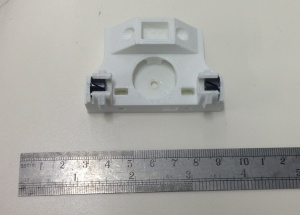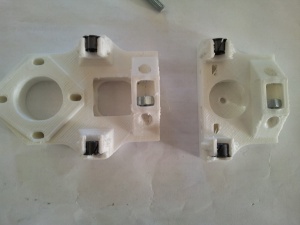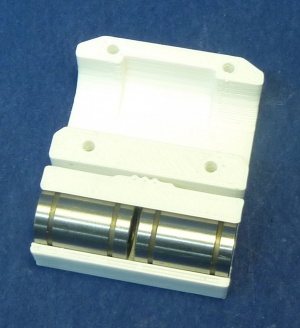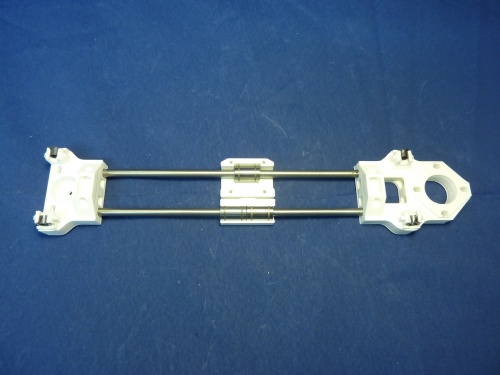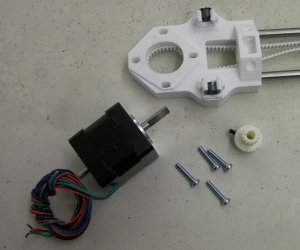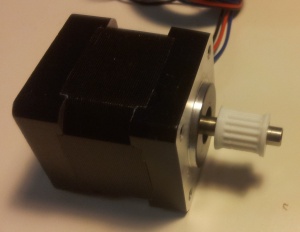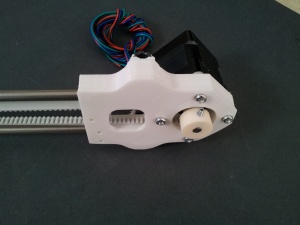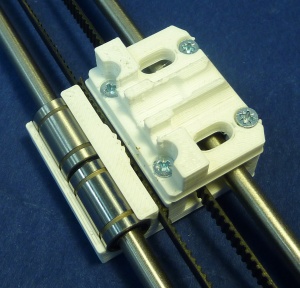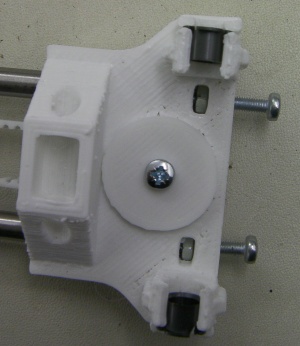Goal
By the end of this stage, your X axis will look like this:
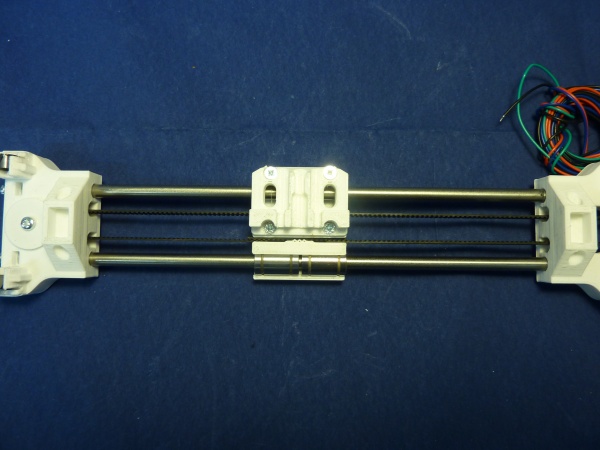
Tools
You will need the following tools:
- Phillips screwdriver
- Long-nosed pliers
- 5.5mm drill bit
- 6mm drill bit
- Half round needle file or 7mm drill bit
- Knife
X axis rails
| RP parts | Quantity | 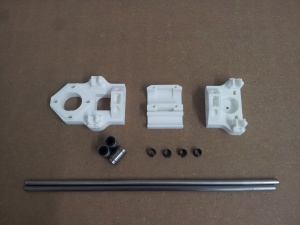 |
 |
1 | |
 |
1 | |
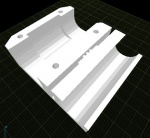 |
1 | |
| Hardware | Quantity | |
| M6 smooth rods 265mm | 2 | |
| LM6UU Linear bearings | 3 | |
| Igus bushings | 4 |
Start by fitting the Igus bushings into the x ends. These bushings need to allow the Z smooth rods to slide easily and without much slack. In order to achieve this, you will need to fit an Igus bushing into position and slide a smooth rod through it.
The bushings can be curled up slightly to fit in downwards. The rims are retained by slots in the 3D-printed parts. Do not attempt to put the bushing in with the smooth rod running through them – this will break the printed part. Put the bushing in on their own, then run the rod through afterwards to check them when they are in place.
If the fit is too tight, remove the igus bushing, then remove a small amount of material from the X end.
Either use the half-round file to remove material, or clamp a 7mm drill in a vice and run the X end up and down it by hand. Take care – it’s better to remove too little and to have to repeat the procedure, than to remove too much irrecoverably.
Try the smooth rod through the bushing again. Repeat this procedure for all four bushing positions.
The holes in the two ends of the X axis where the smooth rods will be fitted are very deep and tend to be very tight fitting; you should ream these out before assembly. Clamp a 6mm drill in a vice and run the holes up and down over it by hand. Again take care not to remove too much – you want a snug fit.
Run a 5.5 mm drill through both Z-axis threaded rod holes (top right in the picture above); these holes must allow the threaded rod to pass through with clearance.
Also check that an M5 nut will fit comfortably into the slot between these holes. If it is too tight, fettle the hole edges with a blade (cut away from your fingers…).
Slide two linear bearings into the bottom of the X carriage from the side, rather than downwards, otherwise you will break the clip.
You can now insert the smooth rods into the X motor end, and slide the other linear bearing onto the top rod (you may need to de-burr the end of the rods with a file to get the bearings on). The smooth rods go a LONG way into the motor mount; make sure they are both fully inserted before you go further.
As with the Y axis smooth rods, if the linear bearings are a little tight, place the smooth rod into an electric drill, then spin the rod whilst rubbing it with a scouring pad. The linear bearing should slide freely along the rod, but without too much play.
Put the X carriage onto the rods.
Add the X idler end, at which point your X axis assembly will look like this:
Before continuing, you should set the distance between the clip bearings to be close to the distance between the Z axis smooth rods. A simple way to do this is to place the X axis assembly above the frame, and looking down through the clip bearings, check that they line up with the tops of the smooth rods. The distance should be 260mm.
X belt
| RP parts | Quantity |  |
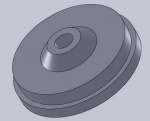 |
1 | |
| Hardware | Quantity | |
| Toothed drive belt | 1 | |
| NEMA14 stepper motor | 1 | |
| M3x16mm screw | 7 | |
| Toothed drive pulley | 1 | |
| 623 bearing | 1 | |
| M3 nut | 3 |
Loop the belt through the idler end as shown. Put a screw through the cover, put the bearing on it, and push the result into the hole in the idler end. Tighten a nut on the back.
Put one end of the belt into the X carriage, gripping it with the little teeth printed in it (see below for a picture).
Loop the other end of the belt through the motor end in a similar manner.
Take an MXL pulley and push it onto the motor shaft, taking care to note its orientation.
If you were supplied with aluminium pulleys (kits since Decemeber 2013), the pulley has a threaded hole in it for a grub screw to hold it on the motor shaft. Install the pulley with the pulley teeth closest to the motor body. The motor shaft has a flat on it; align the grub screw with this, and tighten the grub screw using a 1.5mm Allen key.
If you were supplied with printed plastic pulleys, the bore of the pulley is D shaped to match the motor shaft. One end of the pulley bore is round to make it easier to slide it onto the motor shaft. The pulley should therefore be pushed onto the motor shaft, round end first. It should be a tight fit, and you may have to tap it into place. Use a soft hammer, or a wood block. If you place a tube against the pulley that will fit over the motor shaft, you can tap the end of the tube to place the pulley. Support the motor shaft, not the motor body, from the other end as you tap. You can secure it with a drop of superglue if you like (make sure the shaft is completely free of grease). Take care that no glue gets near the shaft’s entry to the motor.
Leave a gap of about a millimetre between the pulley and the motor body, so the pulley can turn freely, and not rub against the motor body.
Attach the motor to its bracket with four screws. Put the motor at the inside end of the screw slots (i.e. as close to the idler end as possible).
Cut the belt to 580mm for the x-axis belt. The remainder, which should be at least 25mm, pushes into the x-carriage so that it engages with the three teeth. Put the free ends of the belt into the carriage to engage with the short piece of belt already in place. So – you have a short length of belt engaged with the three printed teeth in the X carriage. That short length has its teeth facing downwards. The two ends of the belt (with their teeth facing upwards) engage their teeth with the downward-facing teeth of the short length and are thus retained. The belt should be slack, but only just.
Drop two nuts into the slots in the idler, and put two screws into them. Leave them loose. These are used to adjust the gap between the Igus bearings to match the gap between the Z axis by pushing on the ends of the rods.
Nozzle mount
You will need the nozzle mount RP part and four 12mm self-tapping screws.
Attach the mount to the X carriage with the screws. This will not only hold the hot end, it also retains the top linear bearing in the carriage.

